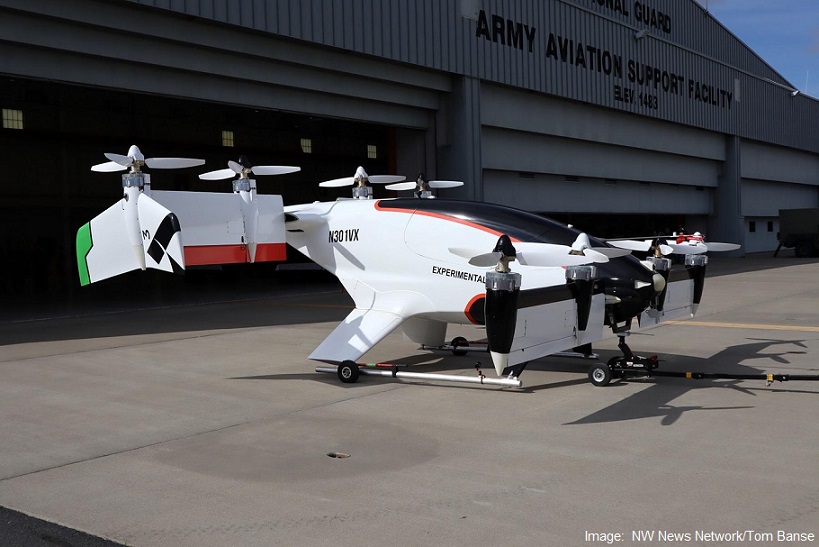Flying Cars for Urban Commutes
October 12, 2019
A drone air taxi designed by Airbus has successfully completed 114 test flights in Pacific Northwest skies.
Airbus, along with its rival Boeing and many others, are striving to make flying cars an option for your urban commute. The enthusiasm around the test flight hangar in Pendleton, Oregon, has to be leavened, though. Industry insiders said the technology is running years ahead of regulators and public acceptance.
You can imagine living life like the Jetsons cartoon family when you stand next to Airbus’ electric, single-seat passenger drone.
“It’s cool and it’s real,” said the head of flight testing, Matt Deal, as curious attendees from a regional drone industry conference admired the futuristic prototype in a hangar at the Pendleton airport.
“No crashes, no nothing. It’s been great so far,” Deal told public radio. “Over 100 takeoffs and landings, all self-piloted. So there is no pilot either on the ground or in the vehicle. From the very beginning, we were all autonomous.”
Flight testing continues in the uncongested skies of the Pendleton Unmanned Aerial Systems Test Range.
Airbus named the eight-rotor prototype “Vahana,” an allusion to Hindu mythology and flying carpets. The goal is to offer a faster option for short hops across highly congested big cities — or from suburbs to city centers — at a cost that is competitive with ground taxi fare over the same distance.
Deal said the prototype has a range of around 50 kilometers (31 miles) or about 20 minutes of flight time with fully charged batteries. He said the battery pack makes up almost 40 percent of the weight of the vehicle.
“Vahana was intended to be a technology demonstrator,” Deal said in an interview. “So from the very beginning we just wanted to prove the viability of technology and we’ve done that. From vertical takeoff, through transition, to a cruise speed of over 100 miles per hour, we’ve demonstrated electrification in aviation is not only feasible, it’s feasible now.”
There was no human on board for any of Vahana’s flights. In Europe, the company is flight testing a larger robo-air taxi dubbed CityAirbus. The learnings from both aircraft development programs will be combined into a next iteration. Deal said Airbus is proceeding methodically amid lots of competition worldwide.
For its part, Boeing is testing a two-seat robo-air taxi developed by its Aurora Flight Sciences subsidiary. The Boeing electric vertical-takeoff-and-landing (eVTOL) prototype made its maiden flight in January. It crashed onto a runway in June while flying unmanned at the Manassas, Virginia, airport, suffering substantial damage but causing no injuries to people, according to a preliminary report from the NTSB.
A leading Chinese competitor, Ehang, recently announced it has completed numerous demonstration flights carrying passengers in its two-seat electric flying car.
So, when will you and I get to soar over traffic in a flying Uber that we’ve hailed with a mobile app? That’s still hard to say.
Last week, Pendleton High School students looked over the Airbus drone taxi and pronounced themselves ready to try it out.
“I’d be fine flying in a drone,” said sophomore Dylan McKenzie. “I think it would be an amazing experience.”
“I have enough confidence in the technology that they have put into this and the amount of development they have going into this machine that I trust them,” added fellow student Tripp Sorenson.
Consultant Renee Fellman of Portland was more cautious about boarding a pilotless air taxi.
“I love technology,” Fellman told public radio. “I use technology, but there are too many glitches. Until I am sure, whether it is autonomous cars or autonomous air vehicles, I’m not personally getting in.”
Public acceptance and perceptions of safety are among many remaining hurdles, said University of Washington researcher Don MacKenzie. The engineering professor is currently studying why most people remain wary of autonomous vehicles.
“Our research on road vehicle automation suggests that people are not necessarily ready,” MacKenzie said. “At least the average person is not necessarily ready to trust this technology and go all in on it today based on what they know today.”
MacKenzie said we have passed “the peak of inflated expectations” and now more realism and grounded expectations prevail.
The Federal Aviation Administration still needs to define how it will certify this new class of passenger-carrying aircraft. Separately, governments and aircraft makers are pouring millions of dollars into air traffic control studies. One of those trials will unfold over the inland Northwest soon, in partnership with defense contractor PAE ISR.
The Airbus Vahana team is beginning to research noise from robo-air taxis — yet another issue with more questions than answers.
Civic leaders in Pendleton have embraced the drone test range at the city-owned airport. Airbus and PAE ISR are probably the highest profile tenants among a variety of global aerospace companies that have leased all of the available hangar space around the airfield.
The organizers of the Association of Unmanned Vehicles Systems International drone symposium held in Pendleton in early October enhanced the catchphrase of the city’s signature rodeo to capture the new industry cluster.
“Where Let’r Buck meets Let’r Fly!” the revised slogan read.
Banse, Tom. (2019). “Air taxi by Airbus completes 114 test flights in Northwest skies”. Retrieved from https://m.kuow.org/stories/it-s-cool-and-it-s-real-more-than-100-successful-test-flights-of-robo-air-taxi-over-oregon?_lrsc=b559b863-486c-4b6d-9bb6-58ec0373f599.
